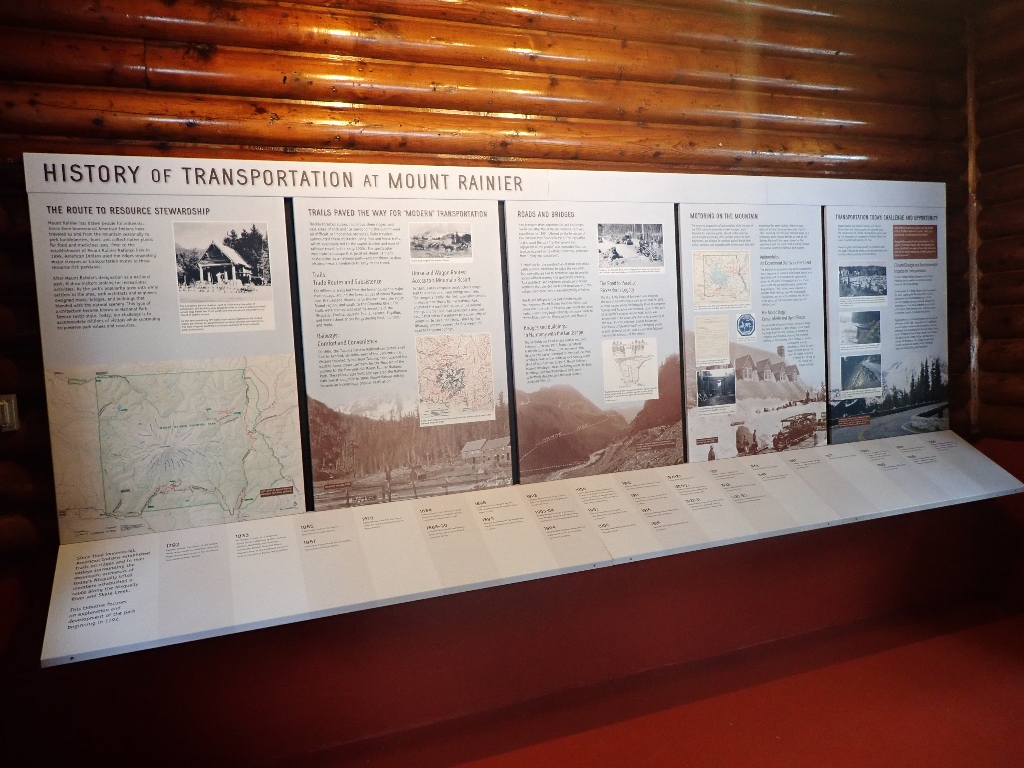
Season: Year-round
Longmire is located in the southwest corner of Mount Rainier National Park and is 6.5 miles (10.5 km) east of the Nisqually Entrance. The Transportation Exhibit is located inside the historic Longmire Service Station, which is next to the National Park Inn. The exhibit is open daily when the Longmire Museum is open. The exhibit panels are attached to the wall across from the door and consist of five panels with a timeline stretching across the bottom of the panels.
History of Transportation at Mount Rainier
Panel 2 Title: Trails Paved the Way for “Modern” Transportation
Panel 2 Main Text
Thickly forested slopes, numerous steep ridges, and vast areas of rock and ice surrounding the summit were all difficult or impossible obstacles. Early travelers surmounted these obstacles using foot and horse trails, which eventually led to the sophistication and ease of railroad travel in the early 1900s. The spectacular mountain landscape that justified Mount Rainier’s designation as a national park—and continues to draw visitors—was a hindrance to early motor travel.
Trails: Trade Routes and Subsistence - For millennia trails led from the lowlands, up the major river valleys, around the lower slopes of Mount Rainier, over the Cascade Mountains to the east, into the Puget Sound region, and south to the Columbia River. The trails were created and used by ancestors of the Nisqually, Cowlitz, Squaxin Island, Yakama, Puyallup, and Muckleshoot tribes for gathering food, hunting, and trade.
Horse and Wagon Routes: Access to a Mountain Resort - In 1884, James Longmire constructed a rough trail to a series of mineral springs near here. The Longmire family, the first non-native settlers in what is now Mount Rainier National Park, promoted the medicinal values of the mineral springs and by 1889, had developed a primitive resort that led to the present park community of Longmire. In 1893, the family, aided by five Nisqually Indians, opened the first wagon toll road to Longmire Springs.
Railways: Comfort and Convenience - In 1904, the Tacoma Eastern Railroad completed a rail line to Ashford, six miles west of the park entrance. Visitors traveled by rail from Tacoma, then boarded the waiting horse drawn carriages for the final leg of the journey to the five-year-old Mount Rainier National Park. The railroad also built and operated the National Park Inn at Longmire in 1906. Mount Rainier quickly became an increasingly popular destination.
Panel 2 Description
The text fills the top two-thirds of the panel in two columns against a pale blue background. At the top of the right-side column is a small black and white photo of two horse-drawn wagons in a subalpine meadow in front of a glaciated mountain peak partly hidden by clouds. Rows of people sit in the wagons. A caption below the photo reads “Horses and wagons at Paradise, 1900s.” Further down the column is a historic map of Mount Rainier filled with numerous faint lines of topographic layers and sketched out trails and roads. A caption below the map reads “A 1907 park map showing long used American Indian trails as well as the planned Nisqually Road”. The bottom third of the panel is filled with a historic sepia-toned photo that fades into the blue background of the rest of the panel at the top. The photo, labeled “Longmire Springs 1904” shows a meadow in a forest with Mount Rainier rising in the background over the forest. A wood fence frames the meadow, with a spring with a low stone wall in the middle of the meadow. On the right side of the image is a large, two-story wood building.
Panel 1: The Route to Resource Stewardship
Panel 3: Roads and Bridges
Panel 4: Motoring on the Mountain
Panel 5: Transportation Today: Challenge and Opportunity
Transportation Timeline
Is there something we missed for this itinerary?
Itineraries across USA


















































